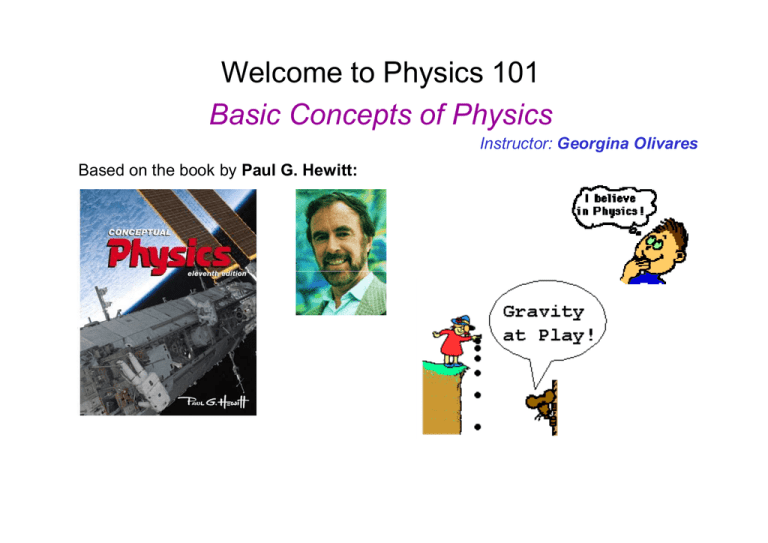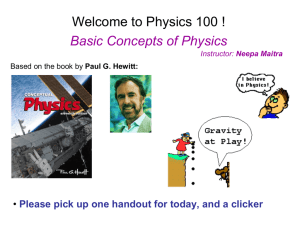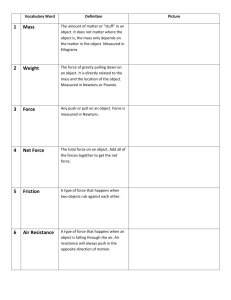
Welcome to Physics 101
Basic Concepts of Physics
Instructor: Georgina Olivares
Based on the book by Paul G. Hewitt:
Course information
Location: Room HW 511
Lecture Times: Tu and Fr: 2.10pm - 3.25pm
Instructor:
Georgina Olivares
email: golivare@hunter.cuny.edu
office: 1200 HN
Office hours: Tu 10:00am-11:00am
Text: Conceptual Physics, 11th Edition, by Paul G. Hewitt (Pearson, Addison-Wesley, 2009).
But 9th and 10th editions are also fine.
Grading:
Attendance/Participation/HW
Laboratory
Midterm Exams
Final Exam
10%
15%
40%
35%
Attendance/Participation/HW: We will make use of “clicker technology” in this course (see more shortly!), and
also have questions to discuss in class.
Laboratory: Make sure you are registered for the lab course, Physics 101 LB.
Midterms: Two mid-term in-class multiple-choice exams: Fri Oct 5 and Fri Nov 9 (Probably).
Final Exam: Fri Dec 21, last day of classes . Exam cumulative, all multiple-choice.
• Note that this is a one-semester terminal physics course, and it does not fulfill the pre-med
physics requirement.
Note from the Office of Student Services:
Book chapter
Topic
Syllabus:
Introduction/Newton’s First Law
1, 2
Linear Motion
3
Newton's Second Law
4
Newton’s Third Law
5
Momentum
6
Energy
7
Rotation
8
Gravity
9
The Atomic Nature of Matter
11
Liquids
13
Gases and Plasmas
14
Heat
15
Vibrations and Waves
19
Sound
20
Electrostatics
22
Electric current
23
Magnetism
24
Electromagnetic Induction
25
Properties of Light
26
Color
27
Reflection and Refraction
28
Light waves
29
Light emission
30
Light Quanta
31
The Atom and the Quantum
32
The Atomic Nucleus and Radioactivity
33
Hunter College regards acts of
academic dishonesty (e.g.,
plagiarism, cheating on
examinations, obtaining unfair
advantage, and falsification of
records and official
documents) as serious
offenses against the values of
intellectual honesty.
The college is committed to
enforcing the CUNY Policy on
Academic Integrity and will
pursue cases of academic
dishonesty according to the
Hunter College Academic
Integrity Procedures.
Clicker Technology and Peer Instruction
Almost all the lectures incorporate a few multiple-choice questions that
test the concepts we are learning. You will individually enter answers via
a clicker, and a bar graph will be instantly generated for you to see how
you all answered.
Then, you will be asked to discuss with your neighbor, and convince
them of your answer*! After a few minutes, you will all re-enter answers
individually and we will all see what happens to the bar graph!
• Participation in this is very important, and useful for you (and fun!).
• Attendance will also be monitored via the clickers – you will enter the
last 4 digits of your SSN at some point in the lecture.
• Importantly, it is your participation that will give you course credit (10%)
for this, NOT the correctness of your actual answers – individual
answers are never correlated with individuals.
* Original idea of Eric Mazur, Harvard University, “Peer Instruction”
Trial Clicker Question!
Please turn on your clickers.
What is Hunter’s motto, translated into English?
A) Ours is to care about your future
B) The care of the future is mine
C)The care of the future is yours
D) Why do today what you can do in the future?
E) The future is yours to keep
Notes on Chapter 1: About Science
•
We will barely cover this in class, and it will not be examined, but I encourage you to
read it on your own.
•
Main points:
Observation of physical evidence is at the basis of science.
Measurement plays a crucial role in science. This process gives you
information about the system you are studying.
Terminology:
Model= Analogy or mental image of the phenomena we are
observing in terms of something we already know. (Waves)
Hypothesis = educated guess
Law = principle = rule
Theory = synthesis of body of info that encompasses welltested and verifiable hypotheses about certain aspects of the natural world. Theories
may change in time!
Beware of pseudoscience! Lacks evidence and falsifiability test.
•
Mathematics provides unambiguous, compact language for science:
- Establishes a relation between concepts,
- and when findings in nature are expressed in mathematical way is
easier to verify or disapprove by experiment.
•
Scientific method:
1.- Recognize a question (unexplained fact)
2.- Make an educated guess (hypothesis)
3.- Make prediction about the consequences of the hypothesis
4.- Perform an experiment or make calculations
5.- Formulate a general rule
•
Concepts to pay attention (will be examined):
–
–
–
–
Hypothesis
Law
Scientific method
Theory
I’d like to take attendance now.
Please enter the last 4 digits of your SSN into your
clicker, and click send..
Chapter 2: Newton’s First Law of Motion –
Inertia
Before getting into this, note ideas on motion prior to Newton (I won’t examine this)
– Aristotle (c. 320 BC), all motions are due to “nature” of the
object, or to “violent” influences (push or pull) .
“Normal state” = at rest, except for celestial bodies.
Heavier objects fall faster, striving harder to achieve their “proper place”.
-- Copernicus (c. 1500’s) doubted that everything revolved
around earth. Formulated sun-centered system.
-- Galileo (c. 1600’s) agreed with Copernicus, and disagreed
also with Aristotle’s “natural state” idea, using observation and experiment.
Dropped objects from Leaning Tower of Pisa and found they fell at the same
rate (apart from small effect of air resistance). Inclined planes experiments.
Concept of Inertia
Read more in your book.
-- Newton (c. 1665) formulated Newton’s Laws of Motion…
Newton’s 1st Law of Motion: Inertia
• Every object in state of rest or motion, will remain in that
state unless something act on it. (something=force)
Eg1: Table here, at rest. If it started moving, we’d look for what caused the
motion .
Eg2: Ball at rest. Give a push (force) – it starts to roll (changes state of motion).
When you let go, it continues to roll, even with no force on it – continuing in its
state of motion.
•
Inertia = property of objects to resist changes in
rest or motion
Heavier (more massive) objects tend to have more inertia –
eg. takes more work to move a truck than to move a chair
• Force = something that produces a change in motion, a
push or a pull.
• Source can be muscle effort, or gravitational, or electric, or
magnetic…Often we denote force by F
Newton, N = standard unit of force.
A familiar force is gravitational force = weight
Eg. 1-kg weighs 9.8-N and 2.2-lb.
Net force = resultant force when several forces are acting on an object .
Eg. Tug of War – both teams pull on opposite ends. If they each pull with
the same magnitude of force, there is zero net force on the rope.
Eg:
Note that any force has a direction!
Equilibrium
Equilibrium is when the net force on something is zero
Mathematically, Σ F = 0
•
An object in equilibrium remains at rest or remains in
uniform straight-line motion (from Newton’s 1st law)
Eg. 2-lb bag of sugar hanging on a weighing scale
There are 2 forces on the bag:
(1) gravitational force downwards towards earth (FG= 9N down)
(2) tension force upwards from stretched spring (FT = 9N up)
Σ F = FT + FG =9N-9N=0
Clicker Question
The staging shown weighs
300 N and supports two
painters, one 250 N and the
other 300 N.
The reading on the left scale is
400 N. what is the reading on
the right-hand scale for the
system to be in equilibrium?
A) 300 N
B) 400 N
C) 450 N
D) 850 N
E) None of the above
Answer
The staging shown weighs 300 N and
supports two painters, one 250 N and
the other 300 N.
The reading on the left scale is 400 N.
what is the reading on the right-hand
scale?
A) 300 N
B) 400 N
C) 450 N
D) 850 N
E) None of the above
The upward forces are (400 N + RH tension). By the equilibrium rule Σ F = 0,
this upward total must equal the downward forces are (250 N + 300 N + 300 N)
= 850 N. Hence, RH tension must be 450 N.
Note that although the two tensions must add to the total weight, the tension is
larger in the rope nearer the heavier person.
Support Force (a.k.a. Normal Force)
What forces are acting on the book lying on the table?
Gravity (weight of book) acts downward. But since book is at
rest, there must be an equal upward force.
This upward force is called the support force, or normal force,
and equals the weight of the book.
Σ F = 0, since at rest
What creates the normal force? The atoms in the table behave
like tiny springs, so push back on anything (eg book) trying to
compress them.
Question
Say a 120-lb person steps on some bathroom scales.
(i)
How much is gravity pulling on her ?
120-lb (=weight)
(ii)
What is the net force on her?
0 (since she’s at rest)
(iii) Now suppose she stands on two bathroom scales, with
weight evenly divided between them. What will each
scale read?
60 –lb each, since the sum of the scale
readings must balance the weight.
Clicker Question
Consider again the 120-lb person who steps on the bathroom
scales.
What is the net force on the bathroom scales?
A) 0
B) 120-lb
C)120 N
D)None of the above
Answer
Consider again the 120-lb person who steps on some bathroom scales.
What is the net force on the bathroom scales?
A) 0
Because the scales are at rest .
B) 120-lb
There are two forces on the
scales: the downward weight of
the person, exactly balanced by
the support force from the floor.
C) 120 N
D) None of the above
Equilibrium of Moving Things
• An object moving at constant speed in a straight line is also in
equilibrium, Σ F = 0.
Question: Can any object on which only one force is
acting, be in equilibrium?
No!
Consider pushing a box across a floor.
(1) What forces are acting on the box?
Weight downward, support force upward, your push across, and
friction between the floor and the box opposing your push.
(2) What can you say about the relative magnitudes of the forces if is moving
with unchanging speed across the floor ?
Magnitude of weight = support force.
Your push = friction, if speed unchanging.
(If it is speeding up, then your push > friction.)
Clicker Question
When the pellet fired into the
spiral tube emerges, which
path will it follow? (Neglect
gravity).
Answer
When the pellet fired into the spiral tube
emerges, which path will it follow?
(Neglect gravity).
B:
While in the tube, the pellet is forced to curve, but when
it gets outside, no force is exerted on the pellet and
(law of inertia) it follows a straight-line path – hence, B.
Clicker Question
When the ball at the end of the
string swings to its lowest
point, the string is cut by a
sharp razor.
What path will the ball then
follow?
Answer
When the ball at the end of the string swings
to its lowest point, the string is cut by a sharp
razor.
What path will the ball then follow?
b) At the moment the string is cut, the ball is moving horizontally. After
the string is cut, there are no horizontal forces, so the ball continues
horizontally at constant speed. But there is the force of gravity which
causes the ball to accelerate downward, so the ball gains speed in
the downward direction. The combination of constant horiz. speed
and downward gain in speed produces the curved (parabolic) path..
Concepts to study
•
•
•
•
•
•
Newton´s first law of motion
Inertia
Force
Net Force
Mechanical equilibrium
Equilibrium rule




